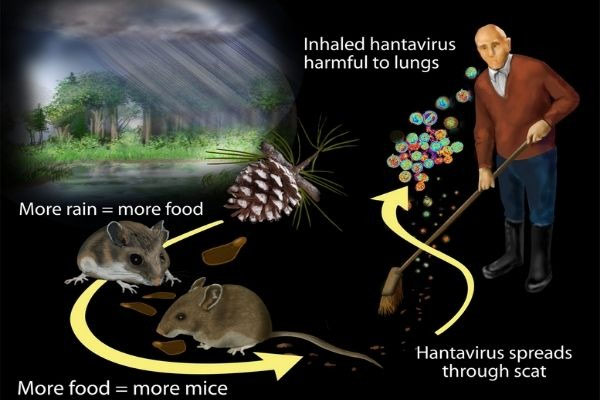
Amid the coronavirus pandemic, a case of the hantavirus has emerged in China claiming the life of a man. It has undoubtedly added on to the fear and chaos people are going through. However, the Centre for Disease Control and Prevention has stated that the virus has sporadic human-to-human spread.
History of Hantavirus:
In May 1993, an outbreak of an unexplained pneumonic illness occurred in the Southwestern United States, in an area shared by Arizona, New Mexico, Colorado and Utah recognised as “The Four Corners”. A young, physically in shape Navajo man tormented by shortness of breath was rushed to a medical institution in New Mexico and but soon he scummed to death.
While reviewing the effects of the case, medical personnel understood that the younger man’s fiancée had died some days earlier after showing similar symptoms, this was a piece of data that proved key to identify the disease.
A series of laboratory exams didn’t perceive any of the deaths as a result of an unacknowledged ailment, which includes bubonic plague. At this point, the CDC Special Pathogens Branch became alert. CDC, the state health departments of New Mexico, Colorado and Utah, the Indian Health Service, the Navajo Nation, and the University of New Mexico all joined together to confront the outbreak.
The particular symptoms and scientific findings pointed researchers away from viable causes, consisting of publicity to a herbicide or a new form of influenza, and closer to some virus. Samples of tissue from sufferers who had gotten the disease were sent to CDC for exhaustive analysis. Virologists at CDC used numerous tests, including new methods to pinpoint virus genes on the molecular level. They were capable of connecting the pulmonary syndrome with a virus, precisely a previously unknown type of hantavirus.

What is it?
The hantavirus is found in the faeces, saliva or urine of rodent. It is transmitted to humans through aerosols ejected by these into the air. By inhaling those aerosols, we stand a threat of catching the virus.
The virus is known after the Hantan River location in South Korea, where one of the early lines of the virus was seen in the 70s.
What are the signs and symptoms?
The preliminary signs and symptoms of the hantavirus infection are fever, muscle aches and dizziness.
The virus displays certainly in either of below-stated form;
The first is hemorrhagic fever with renal failure, and the other is hemorrhagic fever with lung and cardiac involvement.
What takes place after infection?
During the fatal hantavirus hemorrhagic fever with renal syndrome (HFRS), the membrane of blood vessels turn out to be greater permeable, and there may be a drop in blood pressure.
There is fast and dramatic damage determined in kidneys for the duration of worst forms of the disease. For the other fatal illness, hantavirus pulmonary syndrome (HPS), there are muscle aches, fever, fatigue followed by respiratory problems later. The sever damage the virus causes are inside the lung, spleen and gall bladder.
Is there a cure for this?
Vaccines developed for the hantavirus have not been so far wholly a success for all lines of the virus located in extraordinary geographical locations around the world.
However, there is some vaccine which is currently under work-in-progress. So far, the best prevention method stated from getting infected is to keep away from having rodents from homes or offices.
CONSPIRACY THEORY around SARS :
The SARS conspiracy theory started to emerge throughout the excessive acute respiratory syndrome (SARS) outbreak in China within the spring of 2003.
Sergei Kolesnikov, a Russian scientist and a member of the Russian Academy of Medical Sciences, first publicized his claim that the SARS coronavirus is a synthesis of measles and mumps. According to Kolesnikov, this combination can not be formed in the herbal global, and hence the SARS virus must be produced under laboratory conditions.
Another Russian scientist, Nikolai Filatov, head of Moscow’s epidemiological services, had earlier commented that the SARS virus was probably human-made. There have been publications pointing towards this being a human-made virus in China, as were the probes against China after the advent of the coronavirus. However, the following explanations shall clear this doubt to an extent.
Analysis:
Understanding the mechanism of contamination has been tough as hantavirus doesn’t seem to cause the disease within the animals that it infects. There are theories to apprehend why, together with a co-established evolutionary relationship, but none have medical consensus yet.
As of January 23, 2008, hantavirus was found in India; as eastern India grappled with the avian influenza virus H5N1, virologists had found out another shocker: that the existence of threatening hantavirus had additionally surfaced within the country.
In the first record of proof of hantavirus in India, a multi-institutional study had confirmed 28 cases of contamination among sufferers with persistent renal disease, warehouse workers and participants of the Irula tribe engaged in rodent trapping in the Vellore district of Tamil Nadu.
Hence it is not a new concept nor could possibly be a human-made conspiracy of China, and neither would it develop into a corona-like pandemic.





